The Intel SSD 320 Review: 25nm G3 is Finally Here
by Anand Lal Shimpi on March 28, 2011 11:08 AM EST- Posted in
- IT Computing
- Storage
- SSDs
- Intel
- Intel SSD 320
It's called the Intel SSD 320, but the part number should give away just what we're looking at here:
This is the long awaited third generation Intel based SSD. This is the G3. And at this point it's around 6 months late.
Back then it was simply called the Postville Refresh on Intel's roadmaps (Postville was the 34nm Intel X25-M G2). It would use 25nm Intel NAND, feature improved performance and full disk encryption - all behind a 3Gbps SATA interface.
When I spoke with Intel about the drive last year, all indications pointed to it being faster than drives based on SandForce's SF-1200 controller. And it is:
| Intel SSD 320 300GB vs. Corsair Force F120 | ||||
| AT Storage Bench 2011 (Heavy) | AT Storage Bench 2011 (Light) | |||
| Corsair Force F120 | 120.1 MB/s | 155.9 MB/s | ||
| Intel SSD 320 300GB | 132.8 MB/s | 161.7 MB/s | ||
Without turning to any real time compression/deduplication techniques, Intel has built a drive that's faster than the SF-1200. You also get that famed Intel SSD reliability:
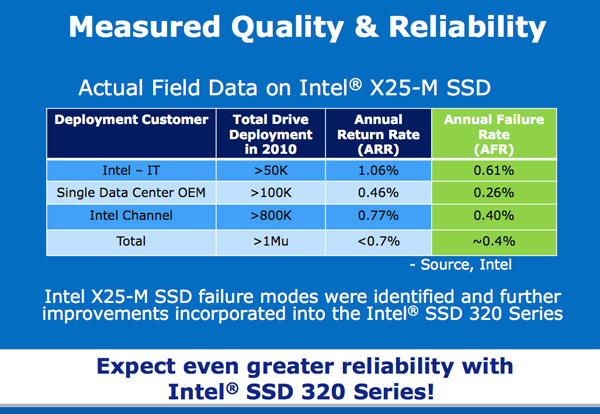
There's just one issue. The SF-1200 was the king of 2010. This year is shaping up to be all about the SF-2200 and the G3 isn't quite as competitive there. Intel realized this as well and thus we got the Intel SSD 510 to address the high performance market. Intel claims the 510 should have the same failure rate as the 34nm X25-M G2 at ~0.6% per year.
The Intel SSD 320 by comparison is aimed at the mainstream market. Remember that's what the M in X25-M always stood for to begin with. As a result we get lower pricing:
| Intel SSD Comparison | ||||||||||||
| X25-M G2 160GB | Intel SSD 320 40GB | Intel SSD 320 80GB | Intel SSD 320 120GB | Intel SSD 320 160GB | Intel SSD 320 300GB | Intel SSD 320 600GB | SSD 510 120GB | SSD 510 250GB | ||||
| User Capacity | 149GB | 37GB | 74GB | 111GB | 149GB | 279GB | 558GB | 111GB | 232GB | |||
| Random Read Performance | Up to 35K IOPS | Up to 30K IOPS | Up to 38K IOPS | Up to 38K IOPS | Up to 39K IOPS | Up to 39.5K IOPS | Up to 39.5K IOPS | Up to 20K IOPS | Up to 20K IOPS | |||
| Random Write Performance | Up to 8.6K IOPS | Up to 3.7K IOPS | Up to 10K IOPS | Up to 14K IOPS | Up to 21K IOPS | Up to 23K IOPS | Up to 23K IOPS | Up to 8K IOPS | Up to 8K IOPS | |||
| Sequential Read Performance | Up to 250MB/s | Up to 200MB/s | Up to 270MB/s | Up to 400MB/s (6Gbps) | Up to 500MB/s (6Gbps) | |||||||
| Sequential Write Performance | Up to 100MB/s | Up to 45MB/s | Up to 90MB/s | Up to 130MB/s | Up to 165MB/s | Up to 205MB/s | Up to 220MB/s | Up to 210MB/s (6Gbps) | Up to 315MB/s (6Gbps) | |||
| Price | $404 | $89 | $159 | $209 | $289 | $529 | $1069 | $284 | $584 | |||
It's still early in the 25nm ramp, but the 25nm Intel SSD 320 is cheaper than the 34nm Intel SSD 510. The only issue is that OCZ is very competitive with its pricing as well and compared to the Vertex 2, Intel's SSD 320 isn't really any cheaper. Intel likes to maintain its 65% profit margins so even though it makes the NAND and the controller in the 320, we're unlikely to see these drives drop below competitive pricing.
Intel expects the 25nm SSD 320 to be even more reliable than the 510 or X25-M.
The Same Controller
The Intel SSD 320, like the 310 and X25-M before it, uses an Intel branded controller. Opening up the 320 reveals a near identical controller to what we saw in the 34nm X25-M G2 housing:
You'll notice the part number is identical to 2009's X25-M G2 controller. In fact, it's the same controller. Apparently the G2 controller had a number of features on-die, but not implemented in firmware. Things like full disk encryption and NAND redundancy never made it out in G2 but are here in the 320 all thanks to new firmware. And no, G2 owners aren't getting it.
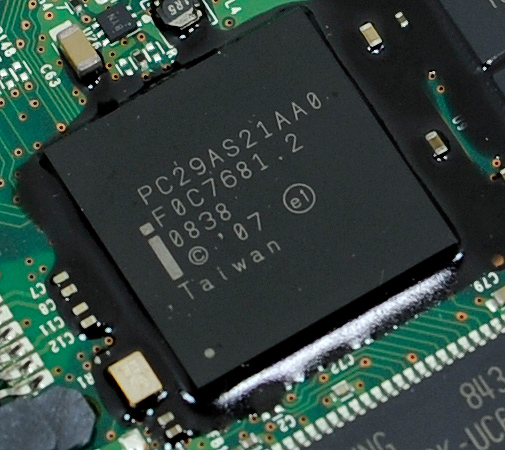
Intel's X25-M G1 Controller
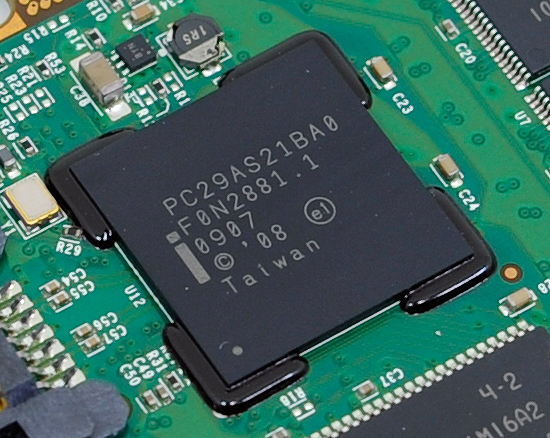
Intel's X25-M G2 Controller
Since the controller hasn't changed, the basic architecture of the SSD hasn't changed either. Intel still doesn't store any user data in its external DRAM cache and there's still a 256KB on-die SRAM.
Next to the Intel controller is a 64MB 166MHz SDRAM device, now made by Hynix. You'll notice that the DRAM chip is a lot smaller than what we've seen in previous X25-M generations, despite growing in capacity. Intel actually turned to mobile SDRAM for use in the SSD 320 to help save on power. While the X25-M G1 and G2 both used a conventional 3.3V SDRAM device, Intel moved to a 1.8V mobile SDRAM chip with the 320.
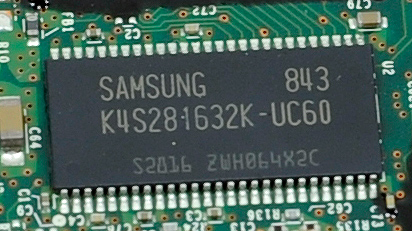
Intel X25-M G1: 16MB 166MHz SDRAM
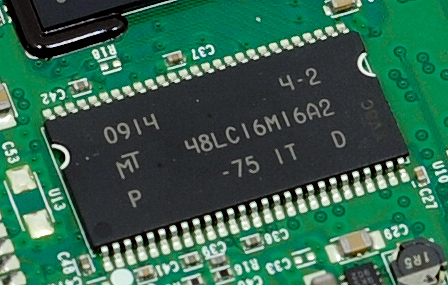
Intel X25-M G2: 32MB 133MHz SDRAM
Intel always prided itself on not storing any user data in its DRAM cache. The external DRAM is only used to cache mapping tables and serve as the controller's scratchpad. In the event of a sudden loss of power, Intel only has to commit whatever data it has in its SRAM to NAND. To minimize the amount of data loss in the event of a sudden power failure, Intel outfitted the SSD 320 with an array of six 470µF capacitors in parallel.
We've seen large capacitors on SSDs before, primarily the enterprise SandForce drives that boast a 0.09F supercap. Intel claims that for its design a single large capacitor isn't necessary given the minimal amount of data that's cached. It further claims that an array of multiple capacitors in parallel allows for much better reliability - if one capacitor fails the array is still useful (vs. a single point of failure in the case of the supercap).



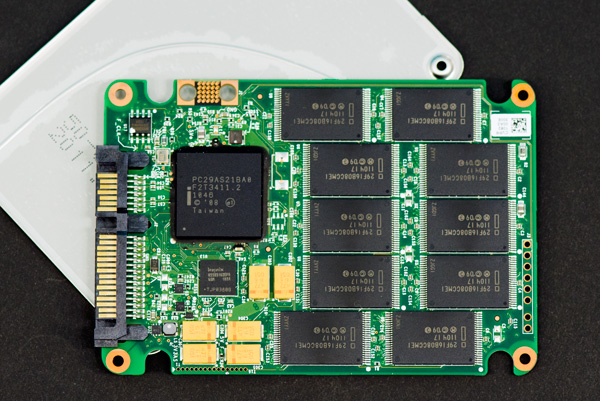
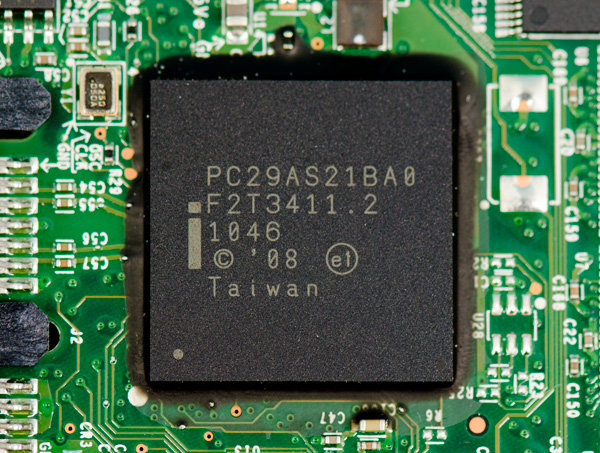
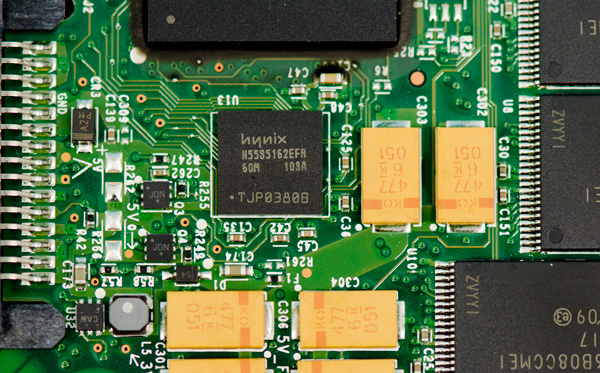









194 Comments
View All Comments
piquadrat - Monday, March 28, 2011 - link
Theoretically for working encryption you need bios with ATA password support. If you're out of luck there is also a way to mod existing bios and add appropriate extension, but skills and experience required.The thing is:
There is no evidence that BIOS password in intel's implementation is LINKED to AES password generated by internal cypher engine!!!
If not, this solution is no different than SF-1200 non-enterprice drives. You can enable ATA pass on OCZ Vertex2 but it is not used to hash internal encryption keys which effectively renders the whole AES thing USELESS (security wise).
wvh - Tuesday, March 29, 2011 - link
Thanks... But I'm even more confused now. ;)piquadrat - Tuesday, March 29, 2011 - link
Lets wait until some further details concerning intel's implementation make to the public. I'm sure that early adopters will test this feature thoroughly. Now all of this is mainly academic.danjw - Monday, March 28, 2011 - link
Have you forgotten the P67 fiasco already?neotiger - Monday, March 28, 2011 - link
So after all these delays Intel released a product that can just barely keep up with the LAST generation of competing products. Meanwhile, competitors are releasing new gen of products at significant performance increases.In other words, Intel just GAVE UP on the top end of the market and is now just trying to be the cheapest product.
Truly disappointing.
FXi - Monday, March 28, 2011 - link
$1069 for a product only guaranteed to work 3 (THREE) years. IF it fails after that time, you've paid over $350 a year for storage. The 300 works out to $190, almost $200 PER YEAR for storage.If Intel feels so confident that these things will last, do the same as the rest of the enterprise grade industry and give it 5 years of "we're positive it will work this long".
Watch the rest of the SSD market cry if Intel does this, but they won't. These things are bad enough if something goes wrong at year 2 or 3, but past that it's the wild west. And given the prices, that shouldn't be the case.
$1069 is a decent price. $999 would have been excellent, but either price is horrible when compared to only a 3 year guaranteed lifespan.
iwod - Monday, March 28, 2011 - link
Personally i think it is too expensive. But,1. It would still sell very well. Because 90% of users are still with SATA 3Gbps. And Intel Drives are the most reliable SSD out there, currently its pricing is not cheap, but competitive.
2. Intel aren't keeping up with production volume anyway for their 25nm SSD. ( Note most of the Intel 25nm NAND sold to other company are proberly Tier -2 Bin NAND )
Yeah, we are disappointed, but it is still going to do well.
Let's Hope Future Intel SSD will beat even the Sandforce 2200 Series.
Lingyis - Monday, March 28, 2011 - link
Reliability is a big issue! I'm not a super-techie, but as a user, having experienced 2 out of 3 Vertex drives that I ended up having to reinstall the OS (once Windows 7, once Mac on my wife's machine) within 6 months, I have reverted to using good'ol hard drives for myself.Intel's higher reliability might be good enough--but hard drives are still more reliable. (if anybody has hard statistics to back me up i'd highly appreciate it)
sean.crees - Tuesday, March 29, 2011 - link
I've personally had MUCH more issues with HDD's than SSD's. Though that likely has to do with the fact that the only SSD's I've worked with are my 2x 1st gen 80g Intel SSD's, and I've spent the last 15 years dealing with HDD's.My biggest issue with HDD's is exposure to heat. I've lost my A/C in the summer, and then subsequently lost all my data on my HDD's because it got too hot for them. You don't have this problem with SSD's.
Also, any tech device is going to have DOA's. Just because you got a bad batch, doesn't mean the entire industry as a whole is worse than older tech. And, OCZ has come a LONG way since their initial reliability issues with their 1st gen Vertex drives. They have listened to their customers, and listened to reviewers like Anand, and have implemented changes to make their products meet our expectations. This one simple act above all else is what pulls me away from the Intel camp to purchase a Vertex 3 for my next SSD.
jwilliams4200 - Tuesday, March 29, 2011 - link
Are you insane? OCZ is meeting expectations?How could you have missed that just in the last few months, OCZ has changed their products to be lower performing and less capacity than previously, without informing customers or even changing the product SKU? Or that OCZ uses Spectek flash instead of higher-tier Micron flash memory in some of their SSDs, but a customer cannot know which flash they got without opening the SSD and voiding their warranty?
OCZ are nothing but con men and spin doctors. If you think OCZ cares about their customers and treats them with honesty and respect, then you are awfully naive.
Besides, the statistics show that Intel is the most reliable SSD. Even without the statistics, it is easy to see why Intel is more reliable. Intel uses the highest quality parts, including getting the highest bin flash memory from their manufacturing lines, and Intel testing and quality control is a corporation wide thing. I doubt OCZ even knows the meaning of the words.